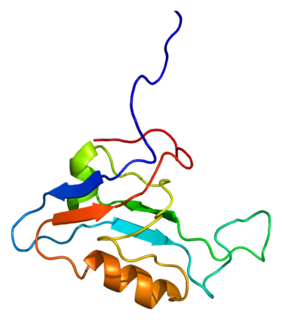Protocadherin Fat 4, also known as cadherin family member 14 (CDHF14) or FAT tumor suppressor homolog 4 (FAT4), is a protein that in humans is encoded by the FAT4 gene. [5] [6]
FAT4 is associated with the Hippo signaling pathway. [7]
Protocadherin Fat 4, also known as cadherin family member 14 (CDHF14) or FAT tumor suppressor homolog 4 (FAT4), is a protein that in humans is encoded by the FAT4 gene. [5] [6]
FAT4 is associated with the Hippo signaling pathway. [7]
Mutations in FAT4 are associated to Hennekam syndrome. [8]

Beta-catenin-interacting protein 1 is a protein that is encoded in humans by the CTNNBIP1 gene.

Hsc70-interacting protein also known as suppression of tumorigenicity 13 (ST13) is a protein that in humans is encoded by the ST13 gene.

SCRIB, also known as Scribble, SCRIBL, or Scribbled homolog (Drosophila), is a scaffold protein which in humans is encoded by the SCRIB gene. It was originally isolated in Drosophila melanogaster in a pathway with DLGAP5 and LLGL1 as a tumor suppressor. In humans, SCRIB is found as a membrane protein and is involved in cell migration, cell polarity, and cell proliferation in epithelial cells. There is also strong evidence that SCRIB may play a role in cancer progression because of its strong homology to the Drosophila protein.

Dual specificity protein phosphatase CDC14A is an enzyme that in humans is encoded by the CDC14A gene.

Cadherin-4 is a protein that in humans is encoded by the CDH4 gene.

Large tumor suppressor kinase 2 (LATS2) is an enzyme that in humans is encoded by the LATS2 gene.

Protocadherin FAT1 is a protein that in humans is encoded by the FAT1 gene.

Dual specificity protein phosphatase CDC14B is an enzyme that in humans is encoded by the CDC14B gene.

ETS homologous factor is a protein that in humans is encoded by the EHF gene. This gene encodes a protein that belongs to an ETS transcription factor subfamily characterized by epithelial-specific expression (ESEs). The encoded protein acts as a transcriptional repressor and may be associated with asthma susceptibility. This protein may be involved in epithelial differentiation and carcinogenesis.

Glioma tumor suppressor candidate region gene 2 protein is a protein that in humans is encoded by the GLTSCR2 gene.

Protocadherin-1 is a protein that in humans is encoded by the PCDH1 gene.

Lysine-specific demethylase 4B is an enzyme that in humans is encoded by the KDM4B gene. KDM4B belongs to the alpha-ketoglutarate-dependent hydroxylase superfamily.

Protocadherin-10 is a protein that in humans is encoded by the PCDH10 gene.

Forkhead box protein P4 is a protein that in humans is encoded by the FOXP4 gene.

Protein Wnt-5b is a protein that in humans is encoded by the WNT5B gene.

Tumor suppressor candidate 2 is a protein that in humans is encoded by the TUSC2 gene.

Forkhead box protein K1 is a transcription factor of the forkhead box family that in humans is encoded by the FOXK1 gene.

Transmembrane protein 158 is a protein that in humans is encoded by the TMEM158 gene.

Voltage-dependent calcium channel subunit alpha2delta-2 is a protein that in humans is encoded by the CACNA2D2 gene.

Cadherin 10 is a protein that in humans is encoded by the CDH10 gene.